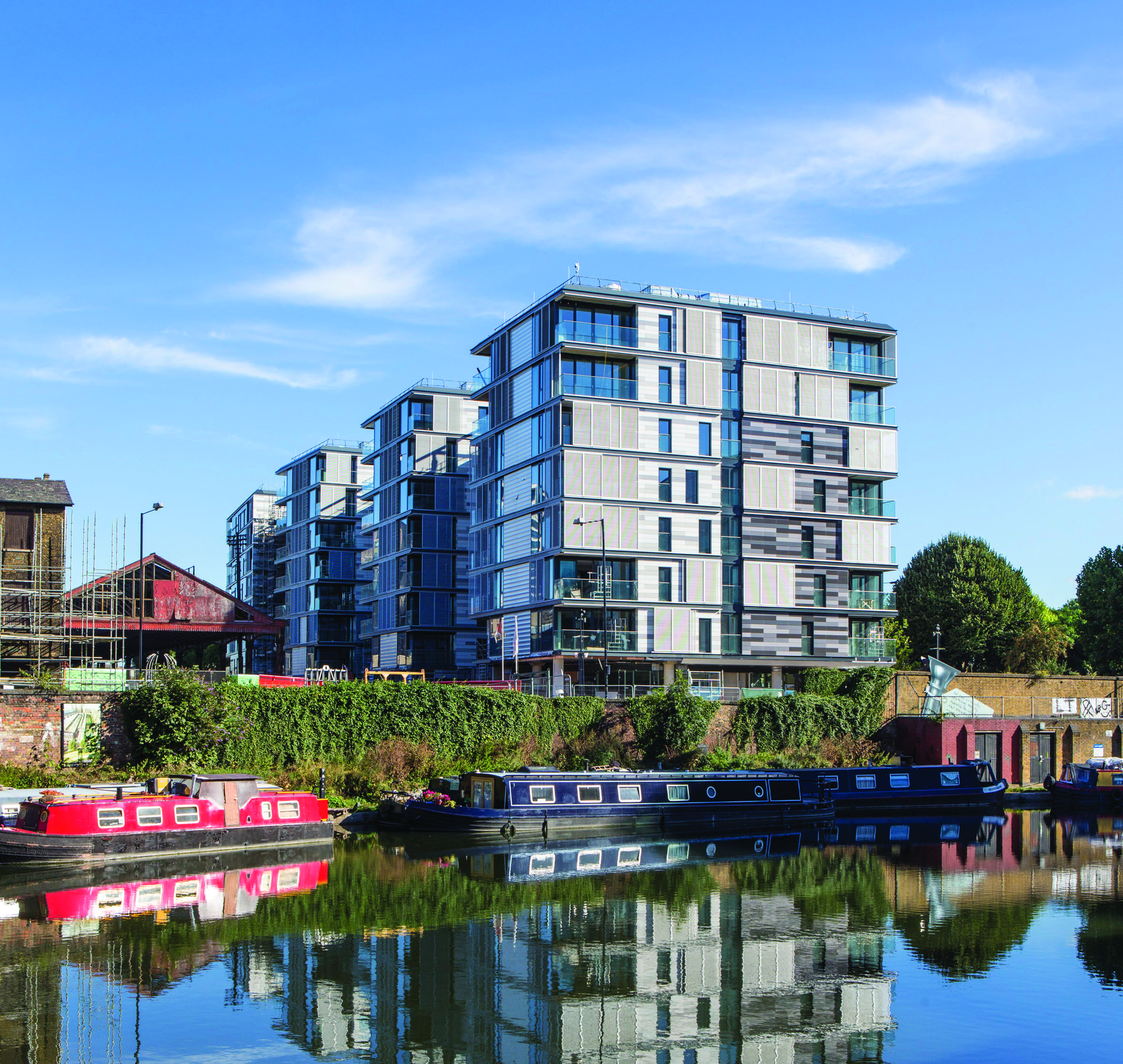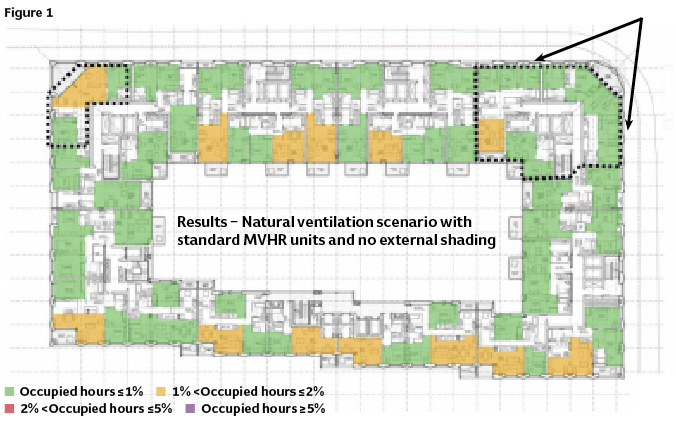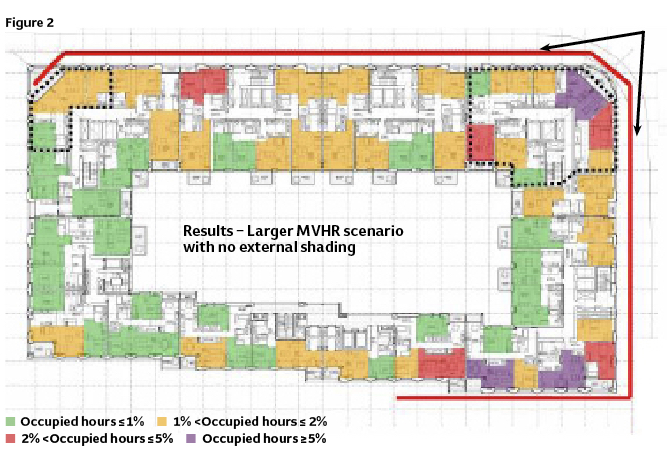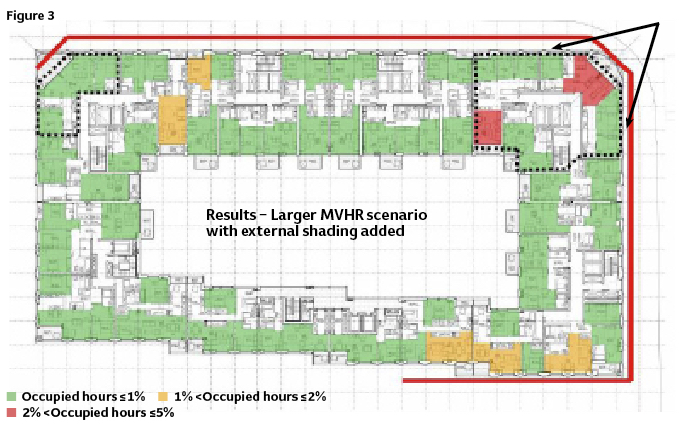
Shading on the ArtHouse apartment scheme at King's Cross. Credit JOHN STURROCK
Residences in London are increasingly being built in noisy locations and on irregular-shaped land. This often results in designs for single-aspect homes with façades exposed to traffic.
At the same time, there has been a drive for large areas of glazing in new apartments, as it is perceived to be popular with buyers.
These trends pose overheating risks for occupants, caused by solar gains from large expanses of glass and the restricted use of openable windows because of street noise. Single aspect designs also offer less opportunity for cross-ventilation.
The London planning guidance1 states that developers should minimise the need for active cooling systems and consider natural means of maintaining comfort (London Plan policy 5.9). This mean designers need to consider passive measures such as shading.
In reality this is hard to achieve. In many apartment buildings the proportion of glazing on the façade is more than 50% – generally less than 35% in older domestic buildings. Population increase means there is a higher density of residential development in London, so less space for dual-aspect flats.
Meanwhile temperatures are on the rise. Most of the hottest years since 1850 have been in the last 10 years and average temperatures have increased by 0.5°C since the 1950s2. Cities in particular are getting hotter and are susceptible to the urban heat island effect.
CIBSE’s overheating criteria for residential design states that operative temperature in living rooms should not exceed 28°C for more than 1% annual occupied hours, while the Passivhaus Overheating Criteria says that air temperature should not exceed 25°C for more than 10% of total annual hours.
While it is difficult to achieve these targets in single-aspect flats in London without openable windows, the acoustic standards presented in BS8233: 2014 Guidance on sound insulation and noise reduction, make it impossible in many circumstances.
This means designers have to turn to mechanical ventilation and heat recovery (MVHR) to prevent overheating and high noise levels.
But there are issues around this technology, particularly around installation and maintenance. For example, filters – critical to the performance of MVHR – often become clogged and are not changed often enough by occupants.3,4,5
Other challenges in urban schemes are smaller dwelling sizes and internal heat gains from communal heating systems, which together raise solar and internal heat loads.
Case study
Hoare Lea modelled a typical London residential development to test a number of scenarios. The project is a multi-storey apartment block with two elevations facing busy roads. External noise levels were measured at 65 dB(A) to 72dB(A), which mean that opening windows for background ventilation and comfort had to be kept to a minimum.
Hoare Lea calculated the acoustic implications for apartments facing the streets: Partially open window offered a 10-15dB reduction in noise levels, to approximately 50-60 dB inside apartment, while closed windows reduced noise inside to 30-35 dB.
Working to these levels Hoare Lea designed each apartment to have MVHR units and openable windows for purge ventilation.
A CIBSE Guide A overheating assessment was undertaken using dynamic thermal modelling software TAS (EDSL) v 9.2.1.3. The 2005 CIBSE weather data for London Heathrow Design Summer Year (DSY) was used.
The baseline scenario includes a standard MVHR unit in the apartments with the flow rates: 18l/s for small living rooms/ bedrooms and 30l/s for larger living rooms/ larger bedrooms.
In order to assess the opportunity to reduce overheating risk a larger MVHR unit was considered, with higher flow rates: 60l/s for small living rooms, 100l/s for larger living rooms and 36l/s for bedrooms.
The larger MVHR unit scenario was assessed with and without external shading (The external shading comprised external louvres at 45°angles).
Results
Natural ventilation with standard MVHR units and no external shading: No overheating risk but opening windows create unreasonable noise levels in the apartments due to external traffic noise (see Figure 1).
Larger MVRH with no external shading: Apartments showing some overheating risk (see Figure 2).
Larger MVRH with external shading: Addition of external shading has resulted in fewer apartments showing overheating risk. Some apartments still show some residual overheating risk. This can be mitigated by further increases in the ventilation rates
(see Figure 3).
Conclusions
Natural ventilation (using openable windows) is not suitable at the site, given the high levels of traffic noise, although modelling shows it would be effective in minimising overheating risk.
Standard MVHR ventilation rates are insufficient to avoid overheating risk at the site.
Higher MVHR ventilation rates reduce overheating risk when combined with external shading.
The recommended solution comprises large MVHR with high ventilation rates, external shading and openable windows for purge ventilation.
Key lessons
-An early review of external noise and ventilation strategies will become increasingly important, especially as dwellings are being planned adjacent busy roads.
-Natural ventilation strategies may be unacceptable from an acoustic perspective. MVHR is increasingly likely to be the future solution.
-The use of external shading, light coloured facades, thermal mass and smaller areas of glazing should be evaluated as passive strategies to complement the MVHR system.
-Dynamic thermal modelling is a useful tool to test the impact of passive measures at pre-planning stage.
-MVHR performance gap issues need to be resolved.
-Impact of the future climate conditions, adaptation and microclimate will be increasingly important (including the urban heat island effect).

Low overheating risk but opening windows creates unreasonable noise levels in the apartments due to external traffic noise

Apartments showing some overheating risk

The addition of the external shading has resulted in fewer apartments showing overheating risk. Some apartments still show some residual overheating risk. This can be mitigated be further increases in the ventilation rates and other measures
Ashley Bateson MCIBSE is a partner at Hoare Lea. He presented on this topic at this year’s Technical Symposium www.cibse.org/technical-symposium-2015




